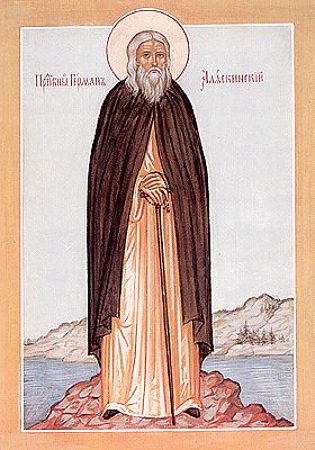
Herman of Alaska was a Russian Orthodox monk and missionary to Alaska, which was then part of Russian America. His gentle approach and ascetic life earned him the love and respect of both the native Alaskans and the Russian colonists. He is considered by many Orthodox Christians to be the patron saint of North America.
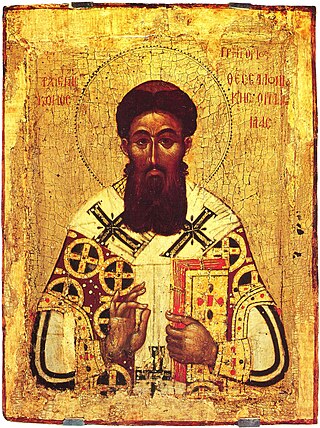
Hesychasm is a contemplative monastic tradition in the Eastern Christian traditions of the Eastern Orthodox Church and Eastern Catholic Churches in which stillness (hēsychia) is sought through uninterrupted Jesus prayer. While rooted in early Christian monasticism, it took its definitive form in the 14th century at Mount Athos.
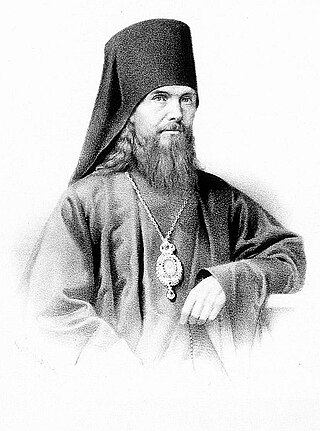
Theophan the Recluse, also known as Theophanes the Recluse or the Enlightener Theophan the Recluse of Vysha, was a Russian Orthodox bishop and theologian, recognized as a saint in 1988. Born as Georgy Vasilievich Govorov, he became a monk in 1841, taking the name Theophan.
The Philokalia is "a collection of texts written between the 4th and 15th centuries by spiritual masters" of the mystical hesychast tradition of the Eastern Orthodox Church. They were originally written for the guidance and instruction of monks in "the practice of the contemplative life". The collection was compiled in the 18th century by Nicodemus the Hagiorite and Macarius of Corinth based on the codices 472, 605, 476, 628 and 629 from the library of the monastery of Vatopedi, Mount Athos.

John Cassian, also known as John the Ascetic and John Cassian the Roman, was a Christian monk and theologian celebrated in both the Western and Eastern churches for his mystical writings. Cassian is noted for his role in bringing the ideas and practices of early Christian monasticism to the medieval West.

Paisius Velichkovsky or Wieliczkowski was an Eastern Orthodox monk and theologian who helped spread staretsdom or the concept of the spiritual elder to the Slavic world. He is a pivotal figure in Orthodox Church history.
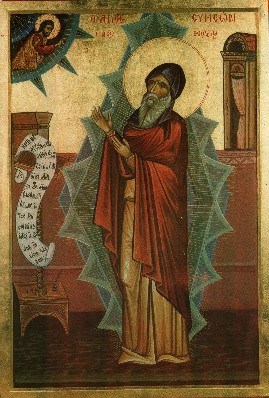
Saint Symeon the New Theologian was an Eastern Orthodox monk and poet who was one of the four saints canonized by the Eastern Orthodox Church and given the title of "Theologian". "Theologian" was not applied to Symeon in the modern academic sense of theological study; the title was intended only to recognize someone who spoke from personal experience of the vision of God. One of his principal teachings was that humans could and should experience theoria.
Callistus I of Constantinople was the Ecumenical Patriarch of Constantinople for two periods from June 1350 to 1353 and from 1354 to 1363. Callistus I was an Athonite monk and supporter of Gregory Palamas. He died in Constantinople in August 1363.

Saint Nilus the Elder of Sinai was one of the many disciples and stalwart defenders of St. John Chrysostom.

Kallistos Ware was an English bishop and theologian of the Eastern Orthodox Church. From 1982, he held the titular bishopric of Diokleia in Phrygia, later made a titular metropolitan bishopric in 2007, under the Ecumenical Patriarchate of Constantinople. He was one of the best-known modern Eastern Orthodox hierarchs and theologians. From 1966 to 2001, he was Spalding Lecturer of Eastern Orthodox Studies at the University of Oxford.

Eastern Christian monasticism is the life followed by monks and nuns of the Eastern Orthodox Church, Oriental Orthodoxy, the Church of the East and some Eastern Catholic Churches.
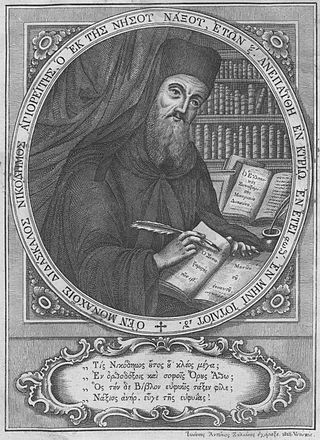
Nicodemus the Hagiorite or Nicodemus of the Holy Mountain was a Greek ascetic monk, mystic, theologian, and philosopher, venerated as a saint in the Eastern Orthodox Church. His life's work was a revival of traditional Christian practices and patristic literature.

Niketas Stethatos was a Byzantine mystic and theologian who is considered a saint by the Eastern Orthodox Church. He was a follower of Symeon the New Theologian and wrote the most complete biography of Symeon, Life of Symeon.

Aerial toll houses are a belief held by some in the Eastern Orthodox Church which states that "following a person's death the soul leaves the body, and is escorted to God by angels. During this journey the soul passes through an aerial realm, which is inhabited by wicked spirits. The soul encounters these demons at various points referred to as toll-houses where the demons then attempt to accuse it of sin and, if possible, drag the soul into hell".

Saint Symeon of Thessalonica was a monk, bishop and theologian in Greece.

August 24 - Eastern Orthodox liturgical calendar - August 26
The Kollyvades were the members of a movement within the Eastern Orthodox Church that began in the second half of the eighteenth century among the monastic community of Mount Athos, which was concerned with the restoration of traditional practices and opposition to unwarranted innovations, and which turned unexpectedly into a movement of spiritual regeneration. As Bishop Kallistos of Diokleia succinctly points out:
throughout the Turkish period the traditions of Hesychasm remained alive, particularly on Mount Athos. Here during the second half of the eighteenth century there arose an important movement of spiritual renewal, whose effects can still be felt today. Its members, known as the Kollyvades, were alarmed at the way in which all too many of their fellow Greeks were falling under the influence of the Western Enlightenment. The Kollyvades were convinced that a regeneration of the Greek nation would come, not through embracing the secular ideas fashionable in the west, but only through a return to the true roots of Orthodox Christianity – through a rediscovery of Patristic theology and Orthodox liturgical life. In particular, they advocated frequent communion – if possible, daily – although at this time most Orthodox communicated only three or four times a year. For this the Kollyvades were fiercely attacked on the Holy Mountain and elsewhere.
Theoleptos of Philadelphia was a Byzantine monk, Metropolitan of Philadelphia (1283/4–1322) and Eastern Orthodox theologian.
Isaiah the Solitary, also known as Isaiah of Gaza, Isaias the Solitary, Abba Isaiah, or possibly also Isaiah of Scetis, was a Christian ascetic and monastic writer known from the Sayings of the Desert Fathers and various Palestinian Miaphysite sources. He is canonized as a saint by the Coptic Orthodox Church, with his feast day on the 11th day of the month Abib (Epip) in the Coptic calendar.

Peter of Damascus or Peter Damascene was an Eastern Christian monastic, theologian, and Church Father who lived in the 12th century. He is notable for being the second most voluminous author in the Philokalia.














